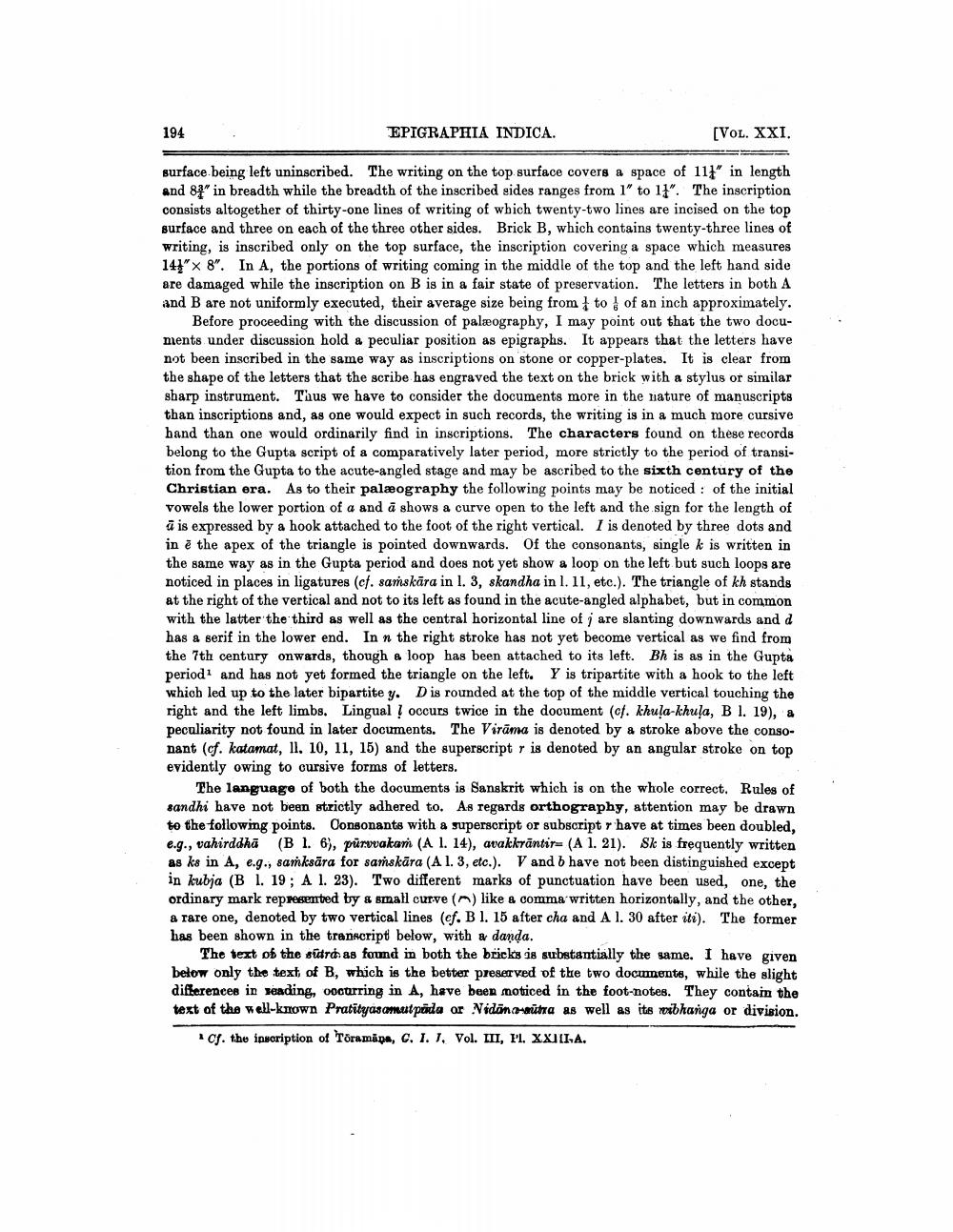________________
194
EPIGRAPHIA INDICA.
[VOL. XXI.
surface being left uninscribed. The writing on the top surface covers a space of 11t" in length and 89" in breadth while the breadth of the inscribed sides ranges from 1" to 11". The inscription consists altogether of thirty-one lines of writing of which twenty-two lines are incised on the top surface and three on each of the three other sides. Brick B, which contains twenty-three lines of writing, is inscribed only on the top surface, the inscription covering a space which measures 141" X 8". In A, the portions of writing coming in the middle of the top and the left hand side are damaged while the inscription on B is in a fair state of preservation. The letters in both A and B are not uniformly executed, their average size being from to of an inch approximately.
Before proceeding with the discussion of palæography, I may point out that the two documents under discussion hold a peculiar position as epigraphs. It appears that the letters have not been inscribed in the same way as inscriptions on stone or copper-plates. It is clear from the shape of the letters that the scribe has engraved the text on the brick with a stylus or similar sharp instrument. Thus we have to consider the documents more in the nature of manuscripts than inscriptions and, as one would expect in such records, the writing is in a much more cursive hand than one would ordinarily find in inscriptions. The characters found on these records belong to the Gupta script of a comparatively later period, more strictly to the period of transition from the Gupta to the acute-angled stage and may be ascribed to the sixth century of the Christian era. As to their palæography the following points may be noticed : of the initial vowels the lower portion of a and a shows a curve open to the left and the sign for the length of ā is expressed by a hook attached to the foot of the right vertical. I is denoted by three dots and in e the apex of the triangle is pointed downwards. Of the consonants, single k is written in the same way as in the Gupta period and does not yet show a loop on the left but such loops are noticed in places in ligatures (cf. samskāra in l. 3, skandha in l. 11, etc.). The triangle of kh stands at the right of the vertical and not to its left as found in the acute-angled alphabet, but in common with the latter the third as well as the central horizontal line of į are slanting downwards and a has a serif in the lower end. In n the right stroke has not yet become vertical as we find from the 7th century onwards, though a loop has been attached to its left. Bh is as in the Gupta periodi and has not yet formed the triangle on the left. Y is tripartite with a hook to the left which led up to the later bipartite y. Dis rounded at the top of the middle vertical touching the right and the left limbs. Lingual | occurs twice in the document (cf. khula-khula, B 1. 19), a peculiarity not found in later documents. The Virāma is denoted by a stroke above the consonant (cf. katamat, ll, 10, 11, 15) and the superscript is denoted by an angular stroke on top evidently owing to cursive forms of letters.
The language of both the documents is Sanskrit which is on the whole correct. Rules of sandhi have not been strictly adhered to. As regards orthography, attention may be drawn to the following points. Consonants with a superscript or subscript , have at times been doubled, e.g., vahirddhā (B 1. 6), pūrvvakaṁ (A 1. 14), avakkrāntir= (A 1. 21). Sk is frequently written as ks in A, e.g., samksāra for saṁskāra (A 1.3, etc.). V and b have not been distinguished except in kubja (B I. 19; A I. 23). Two different marks of punctuation have been used, one, the ordinary mark represented by a small curve (n) like a comma written horizontally, and the other, a rare one, denoted by two vertical lines (cf. B 1. 15 after cha and AI. 30 after iti). The former has been shown in the transcript below, with a danda.
The text of the sidd as found in both the bricks is substantially the same. I have given below only the text of B, which is the better preserved of the two documents, while the slight differences in reading, oocurring in A, have been noticed in the foot-notes. They contain the text of the well-known Pratītyasamutpada or Nidonosūtia as well as its rbhanga or division.
Cf. the inscription of Toramăpa, C. I. 1, Vol. III, L'I. XXILA.




